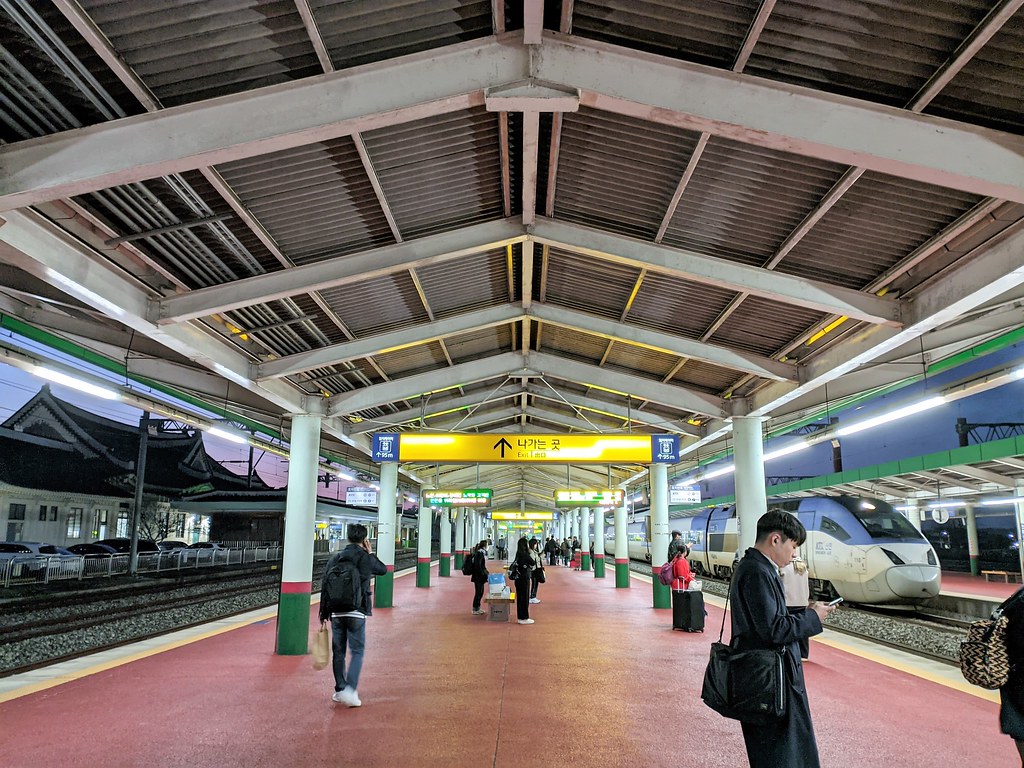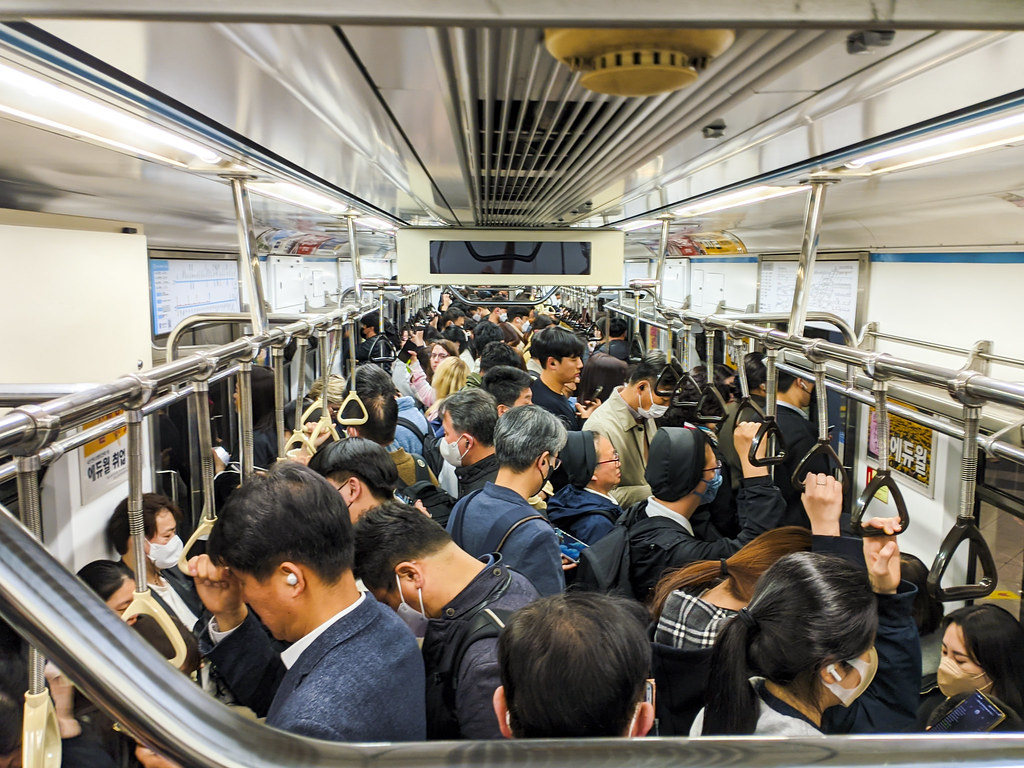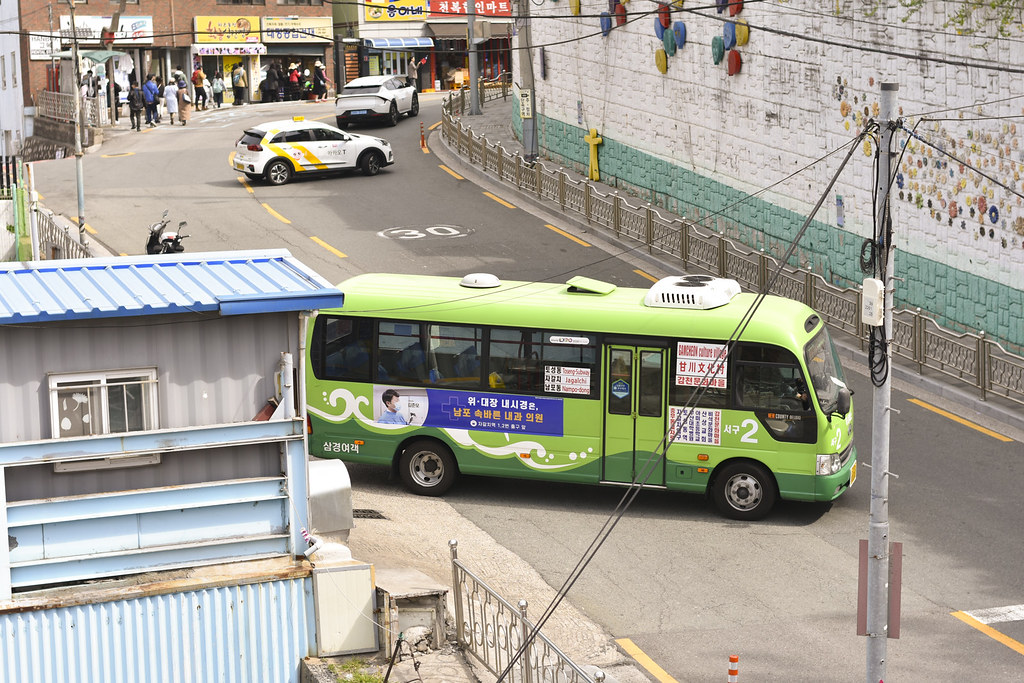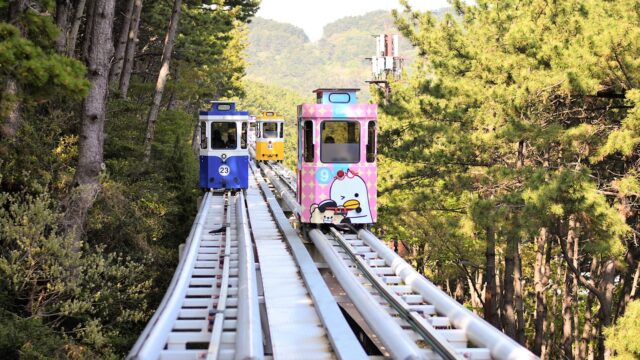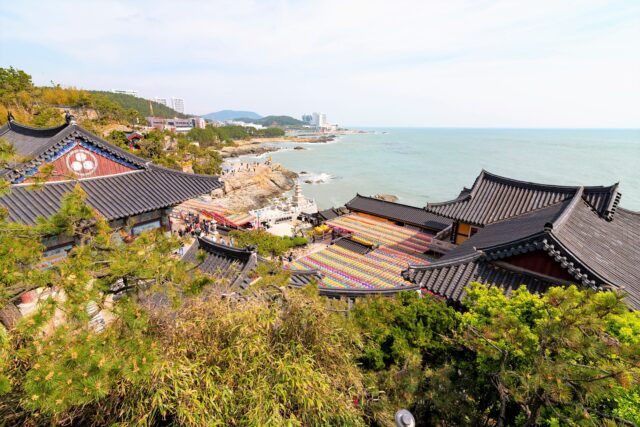South Korea has one of the best public transport networks in the world. Unless you want to go to some remote areas, you will definitely find relevant transportation, whether by train or bus. The main mode of transportation is actually trains, which are very popular. But there is extensive bus network as well.
We do love trains, so whenever we had a chance, we took them, especially when covering big distances. However, we did have to rely on buses sometimes. As everywhere else trains are more expensive, although on some routes the difference is not too great, especially if you aren’t travelling with fast trains.
Inside Seoul, Busan and a few other cities, you have extensive metro systems, as well as bus network, while in smaller cities you will have to rely on buses.
Intercity Travel
Trains
If you want to cover big distances in shorter period of time, train should be your mode of transportation. They certainly aren’t the cheapest, but are convenient. The fastest trains called KTX. We used them on the following routes – Seoul to Gyeongju, Gyeongju to Busan and Jeonju to Seoul. The only longer route, where we didn’t take trains was Busan to Jeonju, given that we would have to change trains mid way and overall travel time would in fact be longer than by direct bus. So we overcame our dislike of buses and took the easier route.
There are also other types of trains, such as ITX, or regular trains depending on your destinations. All routes can be seen on the Korail official website.
Trains are very comfortable mode of transportation and in our case were always on time (even when they arrived late at the starting station).
KTX Seating Charts
On KTX trains only first class wagons have just forward facing seats. The second class one have both – forward and back facing seats. Here is the seating chart, if is important for you to book forward facing seats.
To read these charts, have a look for instance at car 18. If you are traveling from Seoul to wherever, then rows 9-14 are facing in the direction of travel, while 1-8 – back. If instead you are coming to Seoul, these will be vice versa. Check the relevant car here to find out, which seats you want to book.
Buying Train Tickets Online
You would be able to get the train tickets in person, even right before the departure of the train, if they are not overbooked. However, if you are travelling in a busy season (like Sakura or autumn foliage times) or on weekends, you may not find tickets for particular dates and times you may want to travel. So it would be more convenient to buy them online.
Keep in mind, you can only book tickets one month in advance of your travel, no earlier. Korail releases them only at that time. Don’t be fooled by some travel agencies selling you tickets months in advance – they won’t have your ticket, until Korail officially releases tickets and even though they will probably get those tickets for you at that time, it’s still not fully reliable.
You have two options – buying them from the official Korail website, or from the third party ticketing agencies, some of which can overcharge significantly. So be vigilant which website you are using.
We used the Korail official website. The English version can sometimes be glitchy, but it wasn’t too much hassle. Before you open it, make sure you have pop-up blocker disabled, otherwise your payment won’t work.
One major problem with the English version of this site is that it assigns the seats to you directly, without you having any way to choose. Some people would recommend to switch to Korean version, however, it’s no use, as it doesn’t accept foreign cards. So English version is the only option. As we wanted to get forward facing seats, we found the following solution: we filled the information for buying the ticket up to the point, when it assigned us seats (that happens before you make payment), then we checked if the seats were forward facing. When they were not, we closed the browser and started the process again. Each time it assigned us different pair of tickets. We had to repeat this process three times and finally got the forward facing seats.
There is also KorailTalk official app, which you could use to buy tickets, but as in the case of the website, you can’t choose your seats. I guess the method of closing it and restarting the process would work in this case too in order to get assigned different seats, when you don’t like what you got.
Another option, which is viable based on many people’s accounts and my positive experience with the website in several countries, is trip.com. This Chinese agency still does add a commission fee to each ticket, however it is in the range of 3-5 USD, so if you don’t want a hassle with the Korail official website, you can use this easily. The website allows you to choose your own seats and directly tells you whether they face forward or back. Like with Korail website, you can’t buy tickets until one month in advance.
Once you buy your tickets either on the official website or app or on trip.com, you don’t have to print or pick them up. You can have an electronic version of it (however, we were actually never asked to present a ticket anywhere).
Do not buy tickets on Rail Ninja website. It’s not exactly a scam – if you buy ticket there, you probably will have that ticket. However, they charge exorbitant amounts compared to the official ticket prices. You also won’t see what seats you are assigned until after paying.
Korail Pass: Is It Worth It?
As with most thing – it depends on your itinerary and timeframe. Here is the website you can buy it from. It also provides you with details of what type of the pass costs how much. In short, you have options of getting 2-day or 4-day non-consecutive day passes or 3-day or 5-day consecutive day passes. If you are in the group of 2 to 5 people, you get a discount. So you need to calculate for yourself, if it’s worth for your particular itinerary.
For our itinerary it wasn’t worth it at all, as our train tickets were cheaper than the pass. However, if we did just a round trip from Seoul to Busan, the 2-day non-consecutive pass with the saving for 2 people would give us a slight saving.
If you do decide to get the pass, don’t forget to reserve your seats, either via the official website or on the spot. You could still board the train without reserved seats, but you run a risk of standing all through the train ride.
Changing Your Train Tickets in Case of Need
You can actually change your pre-bought online ticket at the station counters for a different date and time. We didn’t expect this to be the case, but one time, when we arrived to the Gyeongju station very early with 2 hours waiting time till the train to Busan we had tickets for, we decided to ask at the counter. They actually easily and quickly changed our ticket to the train, which was gonna leave in 15 minutes. Of course, this was done free of charge.
Of course, changing is only possible, if there are tickets still available for the new time and date. A second time, we wanted to change our ticket from Jeonju to Seoul to an earlier time than on our pre-bought ticket. However, the train was fully booked, so it was not possible.
How to Navigate Korean Train Stations?
First of all, keep in mind that Seoul has more than one train station, from where you may need to take trains:
- Seoul station – you will take KTX to Busan or Gyeongju from here, as well as trains to the airport.
- Yongsan station – KTX from Seoul to Jeonju departs from here. Also if you are going to Nami island or Garden of morning calm, you would take ITX train from here or from Cheongryangri station.
- Cheongryangri station – for heading to Nami island or Garden of morning calm and other eastern parts of the country.
- Yoeungdongpo Station.
Make sure to double check from which train station you need to take your train, as the ticket doesn’t actually tell you.
Busan has only the Busan station for KTX, Gyeongju – Singyeongju station, while Jeonju – Jeonju Jeolla station.
Some people are scared that they may not be able to easily navigate Korean trains. But there is absolutely nothing difficult here, especially if you compare this to Chinese or Japanese systems.
We didn’t need to show up very early, as you don’t have to undergo any security checks (like in China) or pass any ticket machines (like in Japan and China). You can simply have your electronic or printed ticket with you never showing it to anyone and just find your platform and car.
The boards do have English language information, so you won’t have a problem checking your platform.
Luggage on Train and Luggage Storage at the Stations
Korean trains have luggage space at the end of each train car, however, of course, the space is not too big, so if you are travelling with huge suitcases on very busy days, keep in mind to arrive earlier if possible. That said we travelled during the cherry blossom season with one big and one cabin sized suitcase on 3 different routes and did find place to store luggage each time. Many KTX trains do have to overhead luggage space, but only small cabin bags can be stored there.
The train stations, as well as some metro stations in Seoul (like Dongdaemun) do have luggage lockers, however, when we travelled finding a spot for a big suitcase turned out to be impossible at the Seoul train station. We checked at least 5 lockers all around the station, but none had a spot for big luggage, so we (ok, not we, he :D) had to drag the suitcase with us.
Intercity Bus Travel in Korea
There is an extensive intercity bus network in Korea. If you want to save money and/or prefer to travel by bus, it’s quite easy option as well.
There are two major networks – Intercity buses and Express buses. Normally express buses are supposed to take less time, as they run on major highways and make no or few stops, while intercity buses make more stops. However, on some routes they arrive in the same amount of time. For instance, if you travel from Busan to Jeonju, both Intercity and Express buses take 3 hours.
Normally you should be able to get most bus tickets even on the day, but if you are anxious, here is the official website to book your tickets. I personally found it very difficult to navigate, so I decided to wait till we arrived and got bus tickets at the station itself in Busan.
Keep in mind that in big cities there are different bus stations, depending on which – intercity or express – bus you are taking, as well as which direction you are going to. Seoul has several bus stations – 2 express bus terminals and 2 – intercity. Busan has one each. These terminals are usually not too close to each other. For example, Busan intercity bus terminal is in the west of the city near Sasang metro station, while the express bus terminal is all the way in the north, near Nopo station. So make sure to check which bus you need to take, so that you don’t end up at a wrong station.
We took the intercity bus from Busan to Jeonju. It was all right, not too old and ran ok. We encountered no problems and it even arrived earlier than scheduled. That was our only experience with intercity buses in Korea. Let me know if you like them.
Transport Inside the Cities
T Money Card
Get the T-money card as soon as you arrive. This is a universal card, which works on all public transport in the cities. We visited Seoul, Busan, Gyeongju and Jeonju and never needed any other mode of payment than this card. Apparently, this card can even be used to make purchases at some convenience stores, as well as some attractions, but we never tried this.
You can buy the cards at the vending machines at the Incheon airport train station, as well as at the convenience stores and even at some of the art stores, such as Artbox store, which has cutely designed cards. I would have loved to get those from Artbox store, but it would be inconvenient, as we needed to buy one at the airport for immediate use and they only had the regular cards.
The card itself costs 5000 won (which according to the info you get back, if you present it, while leaving the country. We didn’t check this and kept our cards). You charge it with certain amount and then pay fares every time you take transport. Don’t forget that you need to tap while entering the transport, as well as leaving it. This is easy to forget on buses, but do make sure to tap out not to be overcharged.
You can charge the card at the machines at the metro stations (with cash or card), as well as at convenience stores, such as 7/11 and CU (in our experience, these generally only accept cash for charging cards).
Most of the buses now only operate with T money card (most of them had signs that from March 2023 they no longer accept cash). Most probably you will be able to get a one time ticket at the metro stations, however, it’s inconvenient and more expensive than just using the card, so I won’t suggest that hassle.
There are also day passes for tourists, but unless you are extensively travelling by public transport, it doesn’t make sense. for instance, Metropolitan pass for Seoul offers up to 20 rides a day for 15k won for 1 day, 23k for 2 days, etc.
There are also several cards combining transportation with access to attractions. I will discuss them in relevant city guides.
Metro
Several cities in Korea have metro networks. The first and foremost suggestion you get when visiting any of the bigger cities is to find accommodation near a metro station, to make it easier to get around.
Metro is not only fastest transport, as you won’t get stuck in traffic, but also most convenient with English signs.
Accessibility in Korean metros is more or less ensured. There are elevators at many stations we visited, while there are lifts at some stations (I am not sure how well they work).
Finding Your Way Around the Metro Network
As I mentioned earlier, Google maps don’t always work well in Korea. In Seoul and Busan it actually gives directions by transport quite well, however, it has too little information for other cities. So to make sure that you won’t get mistaken directions, download Naver or Kakao maps. We used Naver and it gave directions well, including the information about road closures. It was quite good in its predictions of metro and bus timings (not so much with timings of the buses in smaller cities, but at least it gave correct information about what buses to take).
Seoul metro can be extremely crowded in the rush hour (no, the videos you have seen are not a joke 😊). We ended up taking metro in the evening at about 7 a couple of times and it was almost suffocating, but that’s a big city for you 😊 Oher times it was always easy to take with quite short intervals.
Each of the stations have several exits. Make sure to see on Naver map, which exit you should get out of to get to your destination easily. If you get out of the wrong exit, you may have to walk quite a lot.
If you get tired easily or have any mobility issues, make sure to note on Naver map, where the elevators are – it shows with the sign, which exit has an elevator, and which an escalator. There are also arrow signs for elevators at the stations.
Buses
Buses can sometimes be useful. They have a big network in many cities as we noticed, but they are far more difficult to navigate than metro. The main reason is that they usually don’t have English language information on the bus, so unless you are following the Naver map not to miss your stop, you may not recognize the announcement, unless you know some Korean.
Similarly on the bus stops things are only in Korean, however you don’t need to read that, as you can simply see on a display, when the number you need will be arriving.
We used buses time after time, but mainly outside Seoul. In Seoul we only hopped on the bus once and that didn’t turn out great, as there was a construction and we had to walk to our destination from the bus stop taking far longer route.
In Busan taking buses was all right – we took all sorts of buses from tiny one covering small areas to the ones running through half of the city. If you are taking them in the morning, they can get rather overcrowded and unpleasant.
In Gyeongju buses were all right as well. However, some drivers drove crazy fast. For instance, we got from the train station to the old town in under 7 minutes, which is simply insane 😊
Fun fact: some of the Gyeongju bus stops on the Geumseong-to have the waiting seats heated. That was a very nice find on a windy and cold day 😊
In Jeonju, if you are visiting the old Hanok village area, you will only need buses to/from the train/bus stations. There are quite a few buses running to those stations and you should have no problem catching one.
How to Get to the Airports and Train Stations?
How to Travel from Incheon Airport to Seoul by Public Transport
You have three options, depending on your finances and destination:
- AREX train (cost: 9500 won – T money card or ticket that can be purchased at the train station or convenience stores) – an express train taking approximately 40-45 minutes from the airport to Seoul station.
- All stop train (cost: 4750 won – T money card or ticket that can be purchased at the train station or convenience stores) – as the name says, this is like a normal metro train with a couple dozen stops till Seoul station. It takes 1 hour (so only 15 minutes more than the express train). If you are on a budget and don’t mind spending 15 more minutes, this is the best option for you. Plus, if you are staying in Hongdae, this train would be perfect for you, as it stops at Hongik university stop.
- Airport limousine express bus (cost:17000 won – T money card or ticket that can be purchased with the driver, at the bus station or convenience stores) – bus making less stops and taking about 60-80 minutes depending on traffic. This wouldn’t be my choice, even if the price wasn’t this high, but some people prefer it, as it seems like less hassle with luggage. Plus it goes to Myeongdong directly, where many people stay, so you would not want to take metro with luggage.
- Standard airport bus (cost:7-10000 won – T money card or ticket that can be purchased with the driver, at the bus station or convenience stores) – this option takes longest and would be my least favourite option, but if you are dreading having to change transport with your luggage and don’t mind the buses, this would be more convenient for you, as there are busses going to different parts of the city – Myeongdong, Dongdaemun, Jamsil, etc. If you are arriving to Seoul after 11pm, this is your only option, unless you want to take a taxi.
How to Travel from Gimhae Airport to Busan by Public Transport
- Airport Limousine bus (cost: 6000 won) – one line goes to Seomyen, to Busan station and Nampo and takes from 40 minutes to not sure how long, depending on traffic and destination. Another line travels to Haeundae.
- Airport light rail (cost 1300 won) – you can transfer to Busan metro line 3 at Daejeon or metro line 2 at Sasang.
How to Travel from/to the Seoul Main Train Station
That’s a rather easy task. It’s served by lines 1 and 4 and a number of buses. Keep in mind that you will need to walk out of the metro station to get into the train station, so allocate enough time for this, especially if you are travelling with luggage. Naver normally tells you how much time you would need.
How to Travel from/to the Busan Train Station
The station is served by metro line 1 and a number of buses. Given how spread out the city is, metro is the best way to get around.
How to Travel from/to the Singyeongju Station
Buses run from the north side of the old town area. There are quite a few buses running – 50, 70, 700 to name a few. You need to check Naver, as the numbers can change depending on the day and the time of day.
How to Travel from/to the Jeonju Jeolla Station
Buses run to Jeondong cathedral or to the north side of the hanok village. Do double check with Naver to see which buses run at the time you are taking them.


